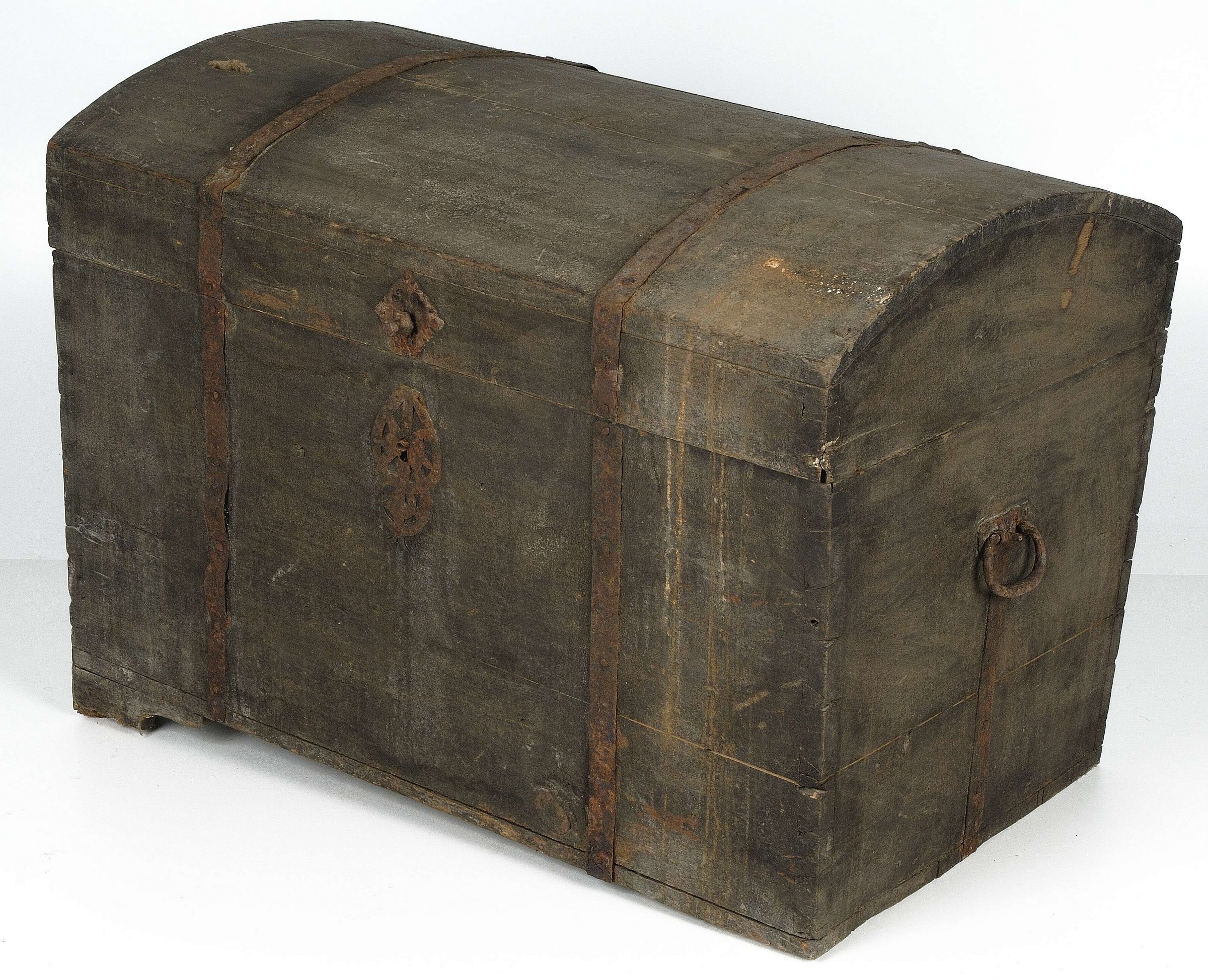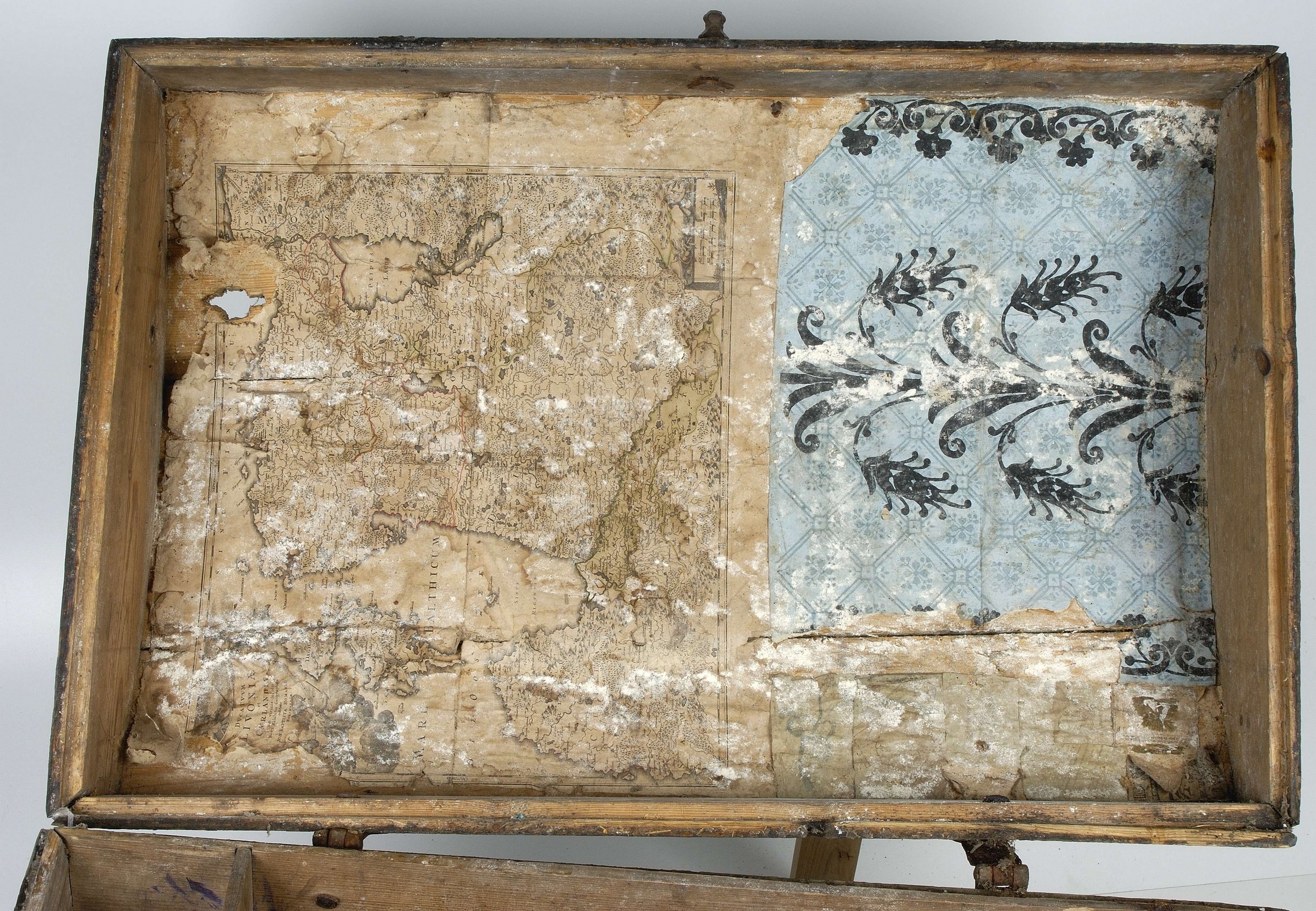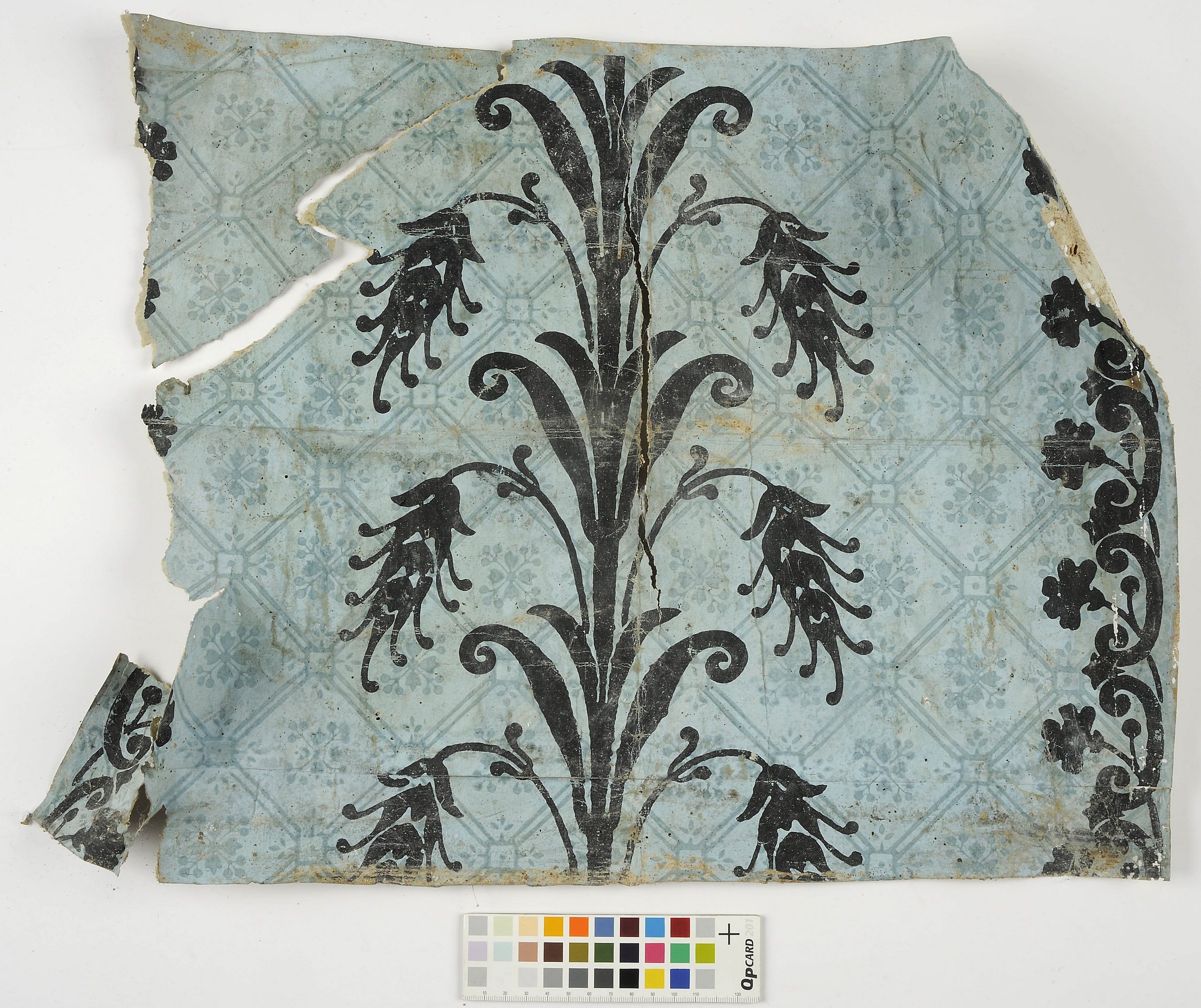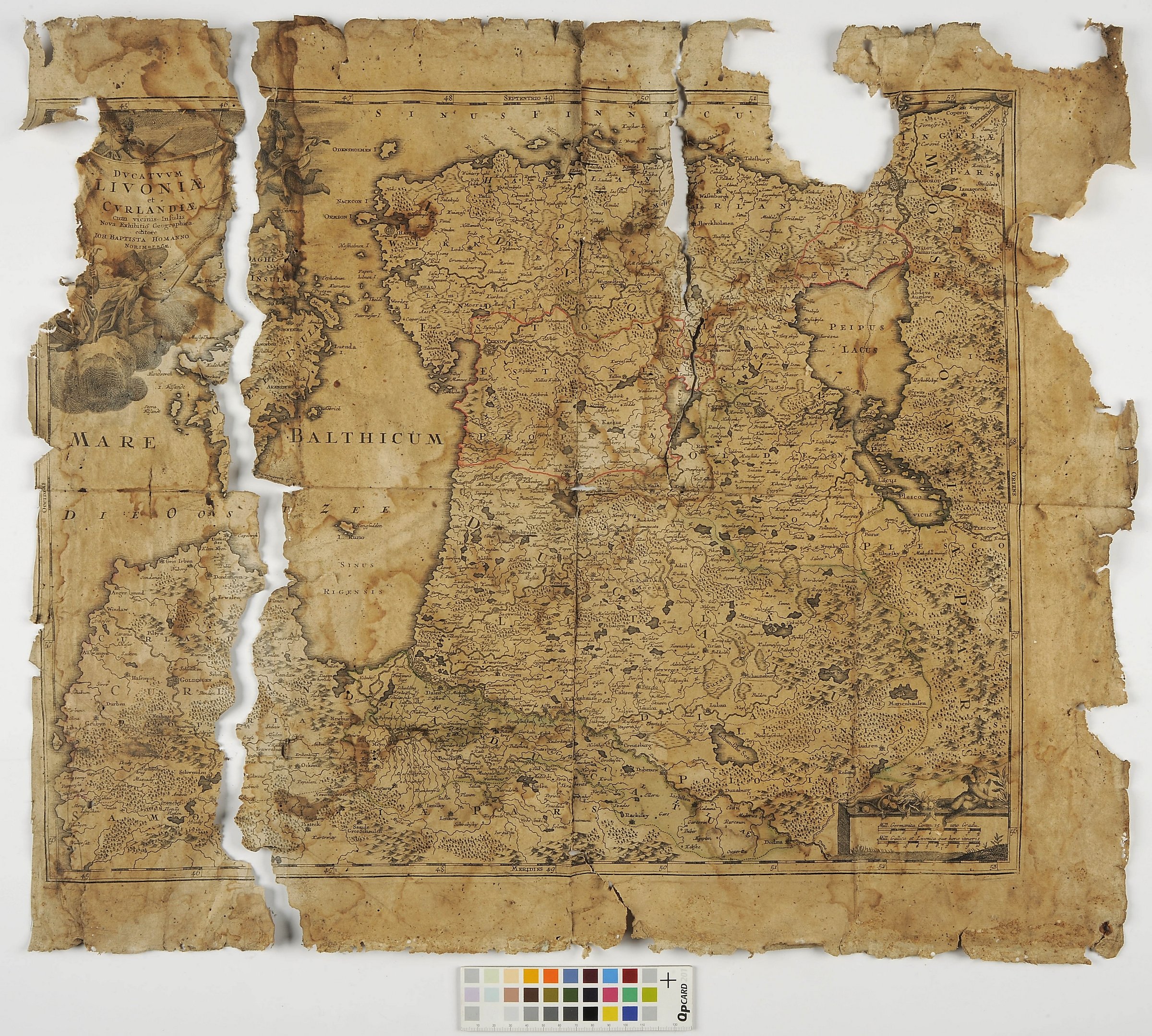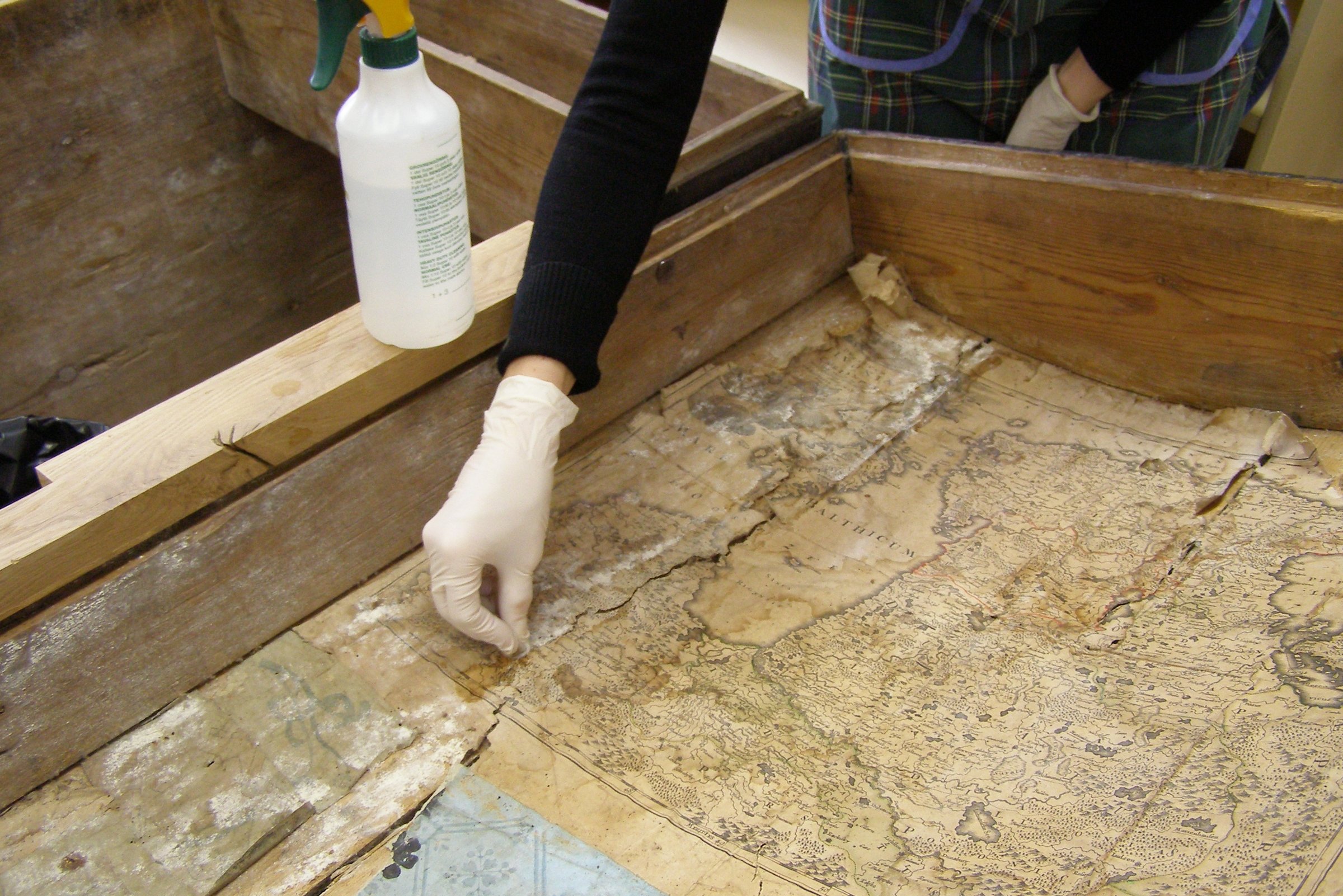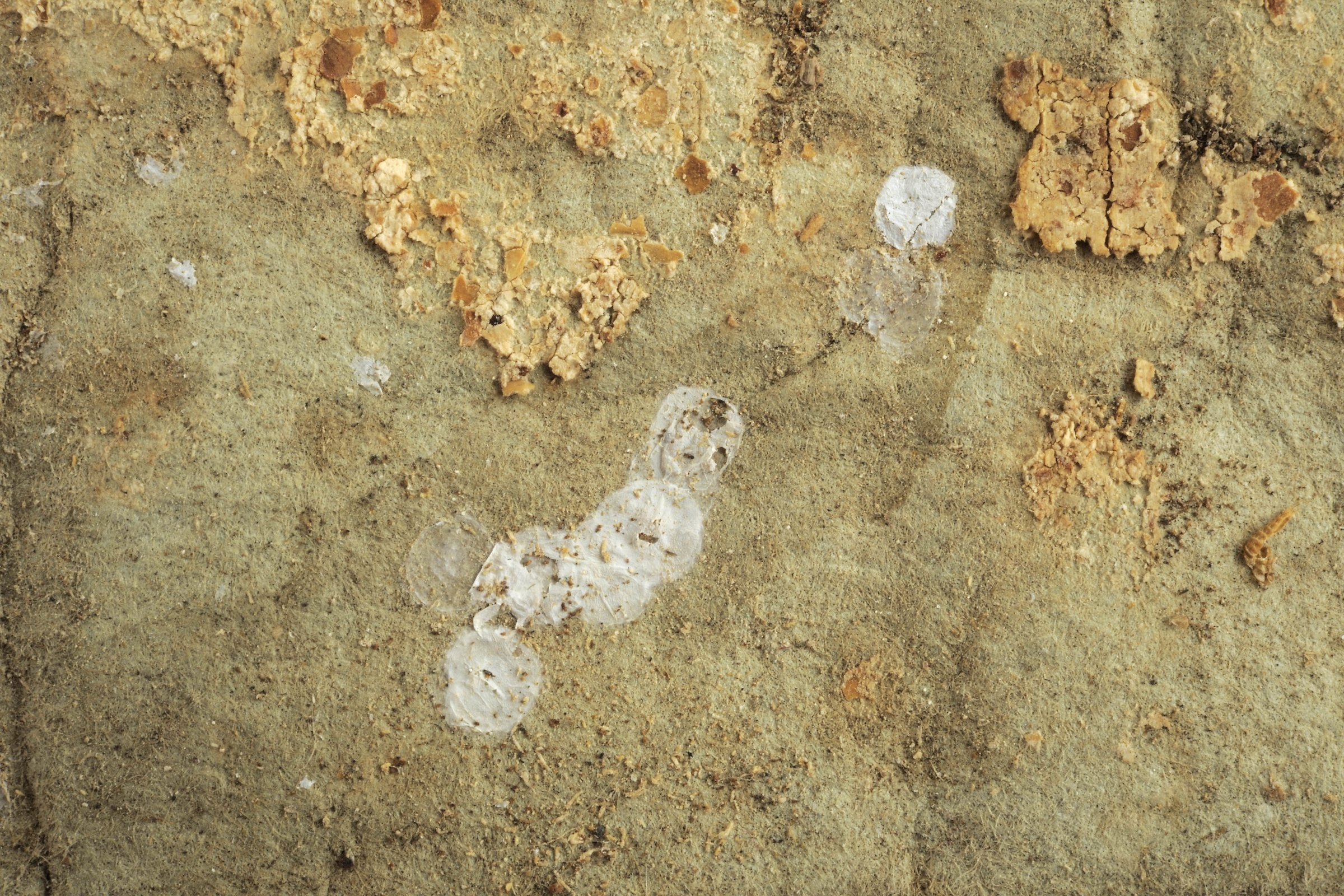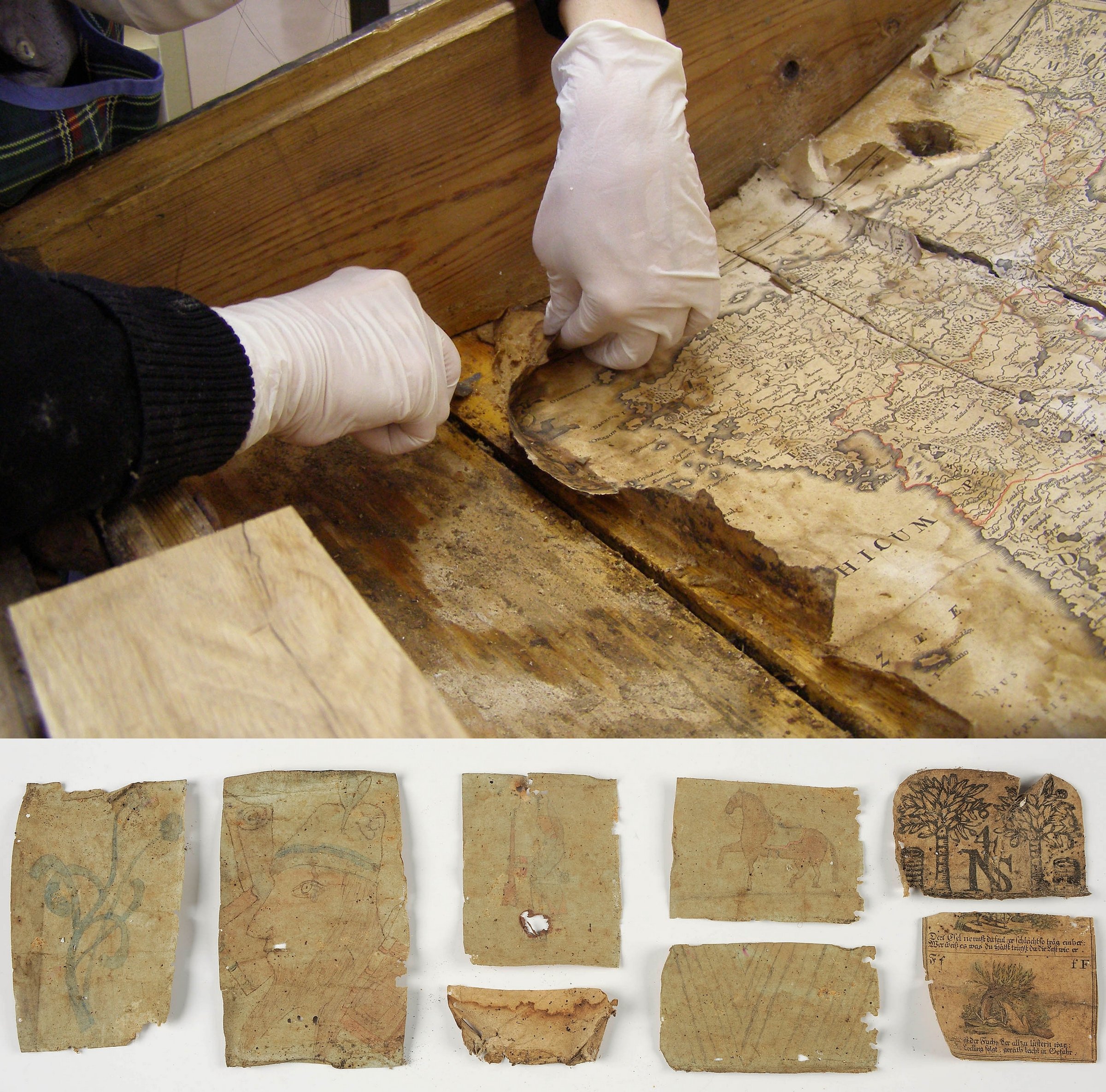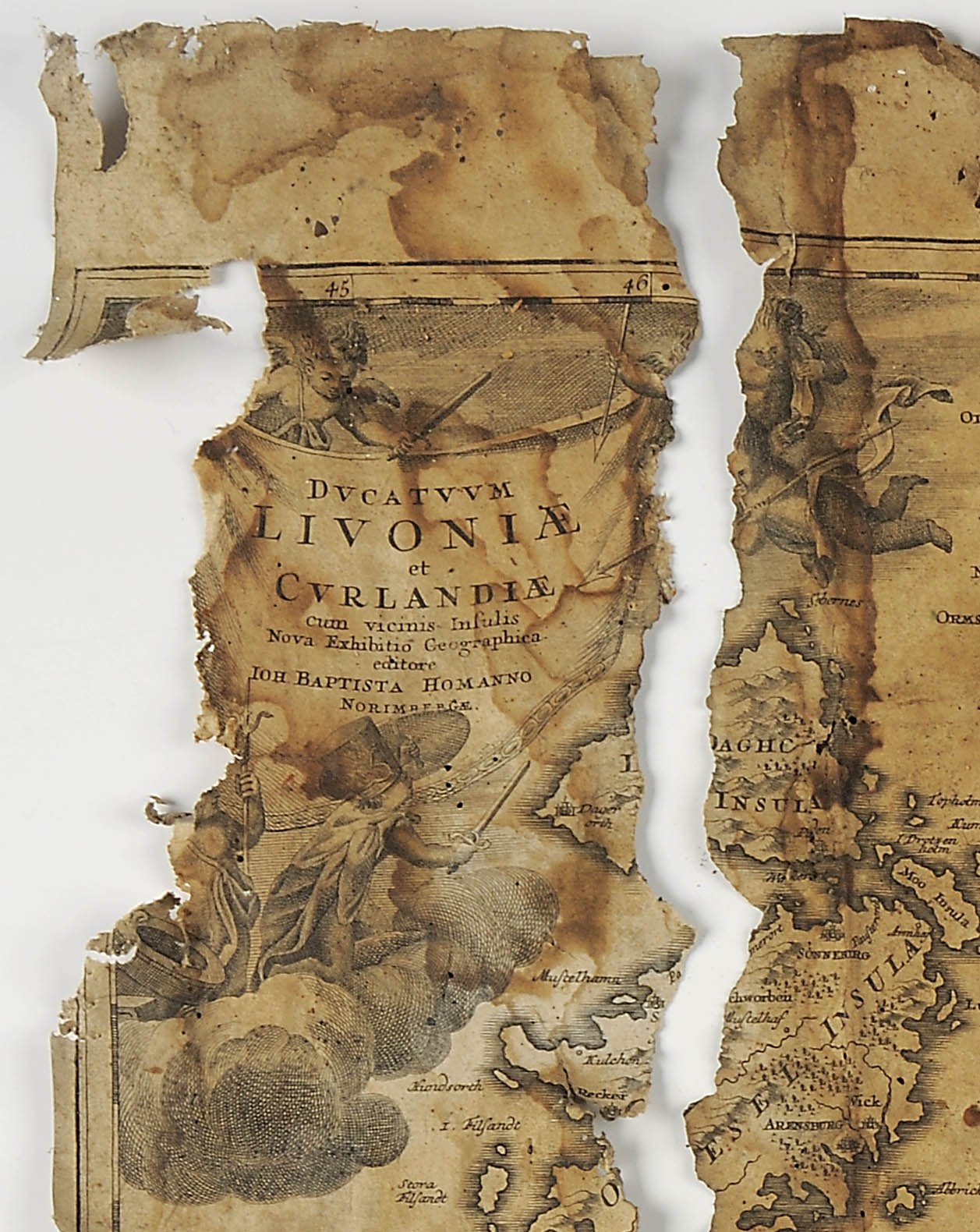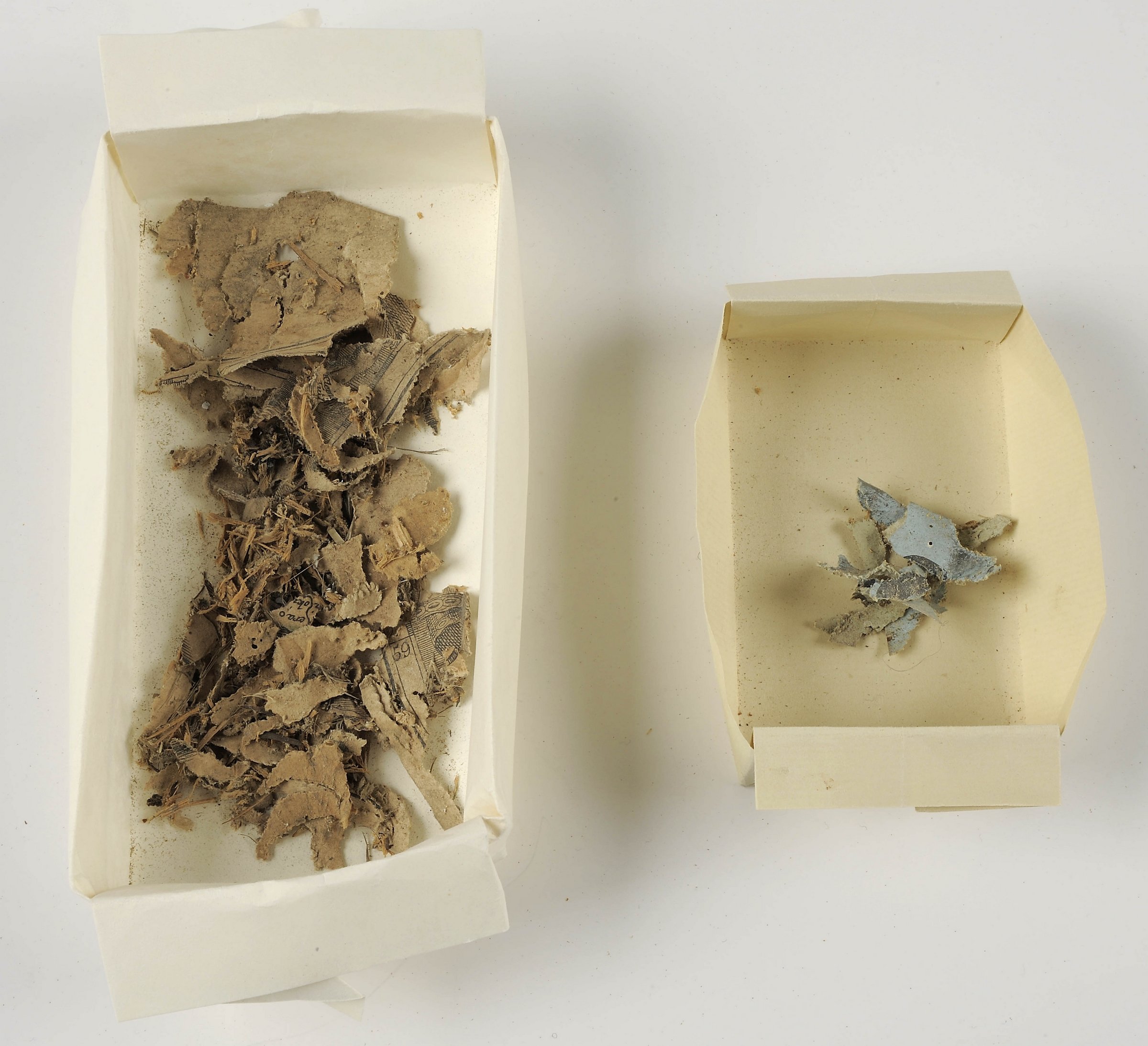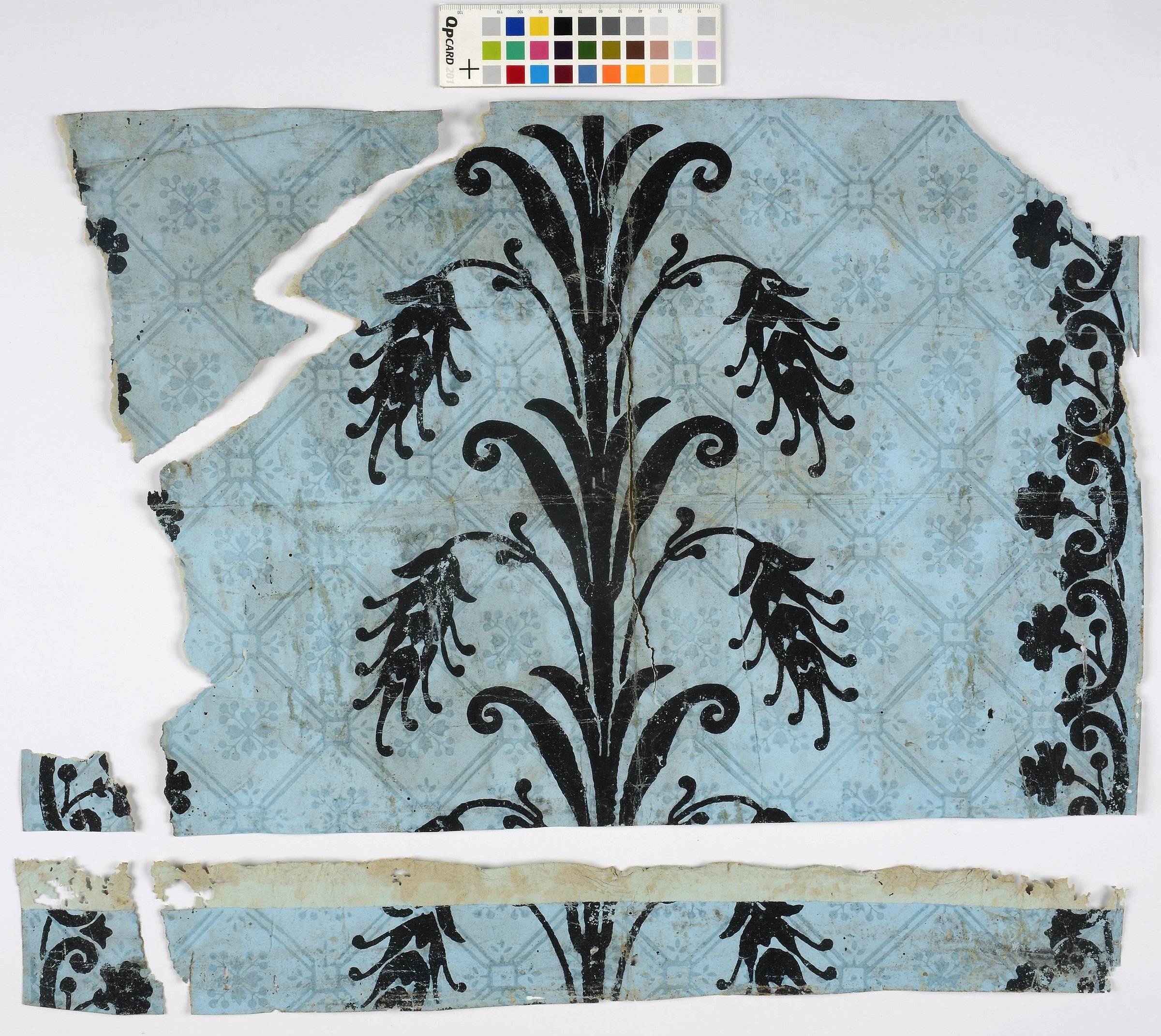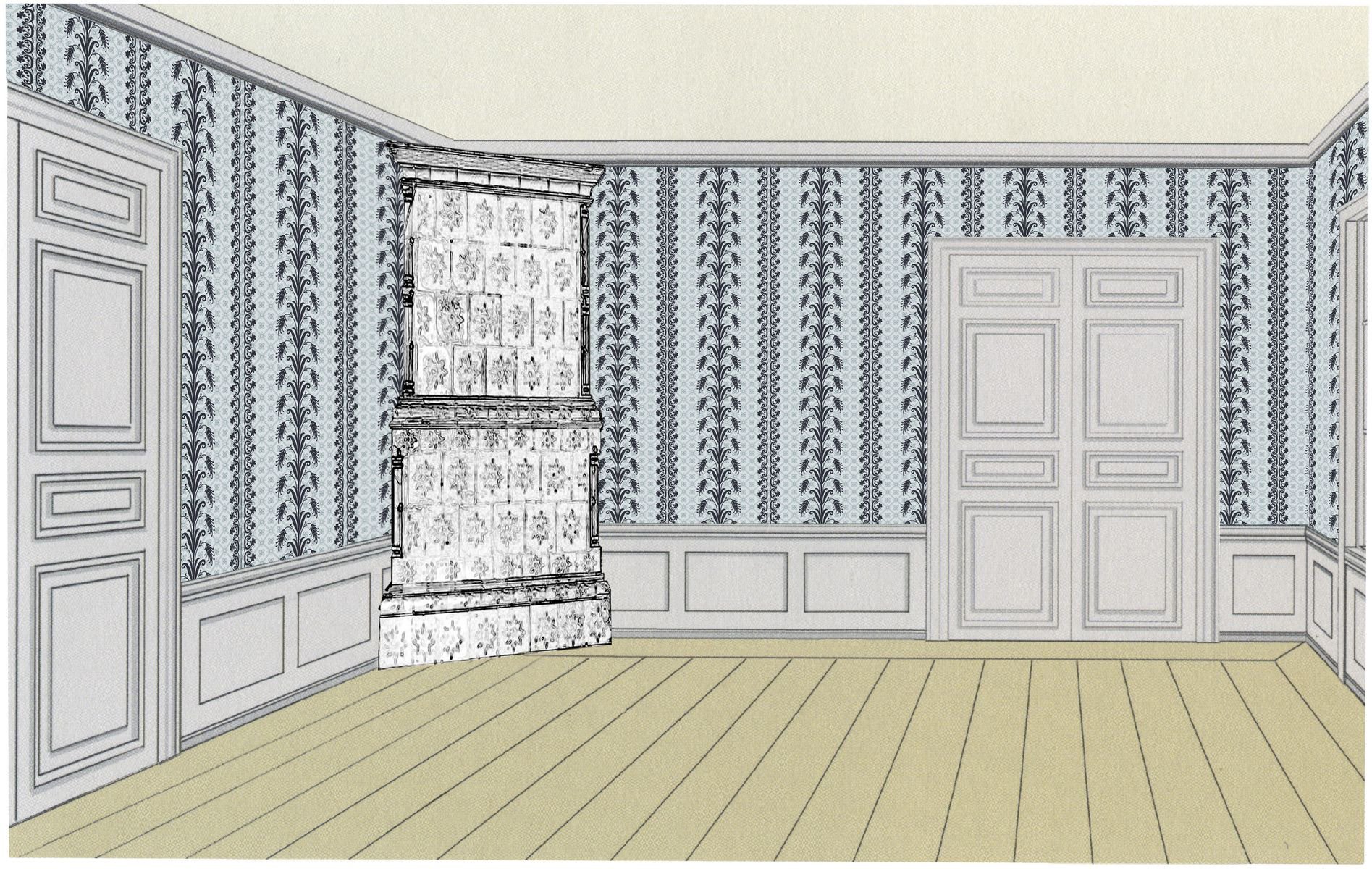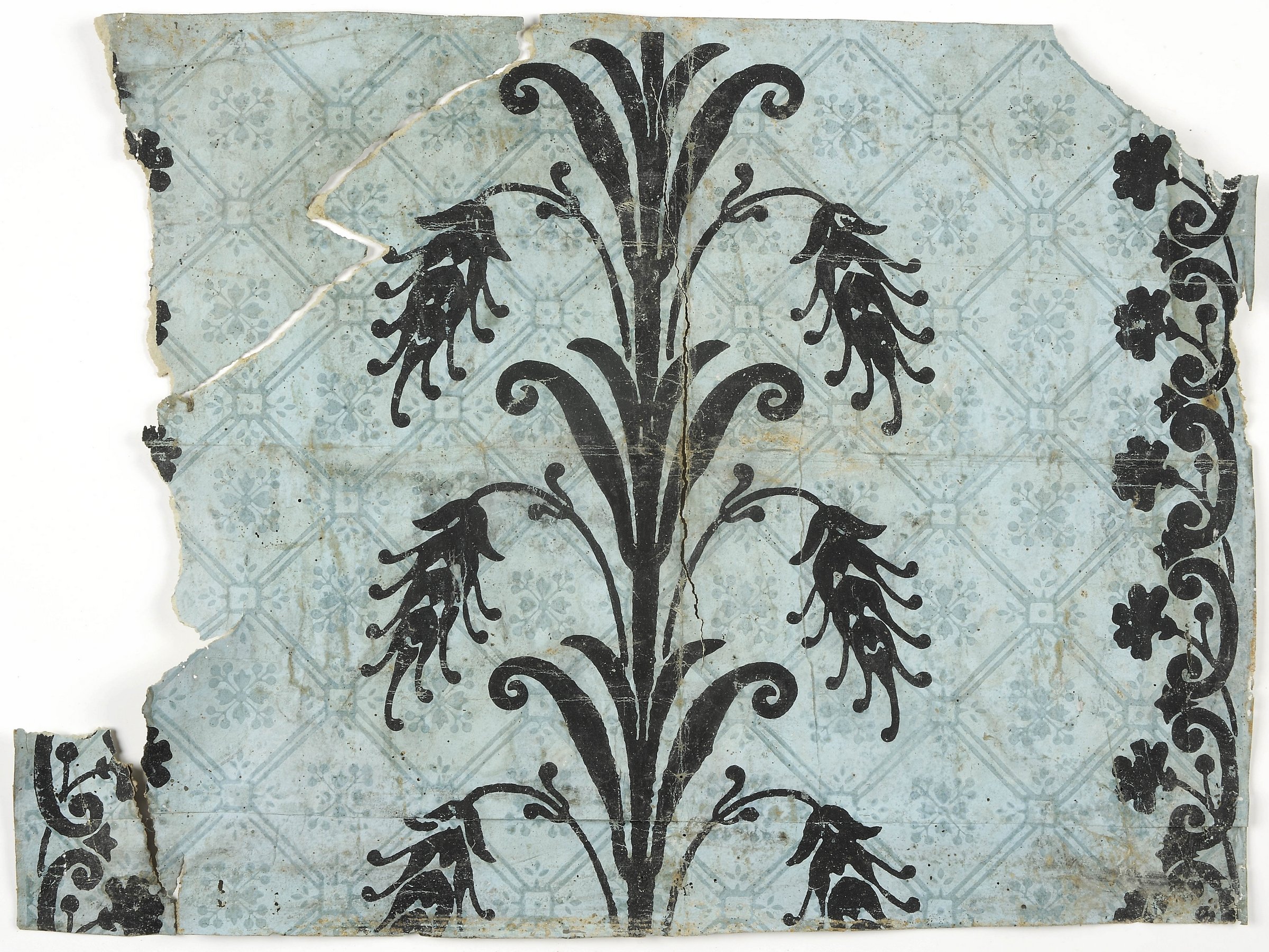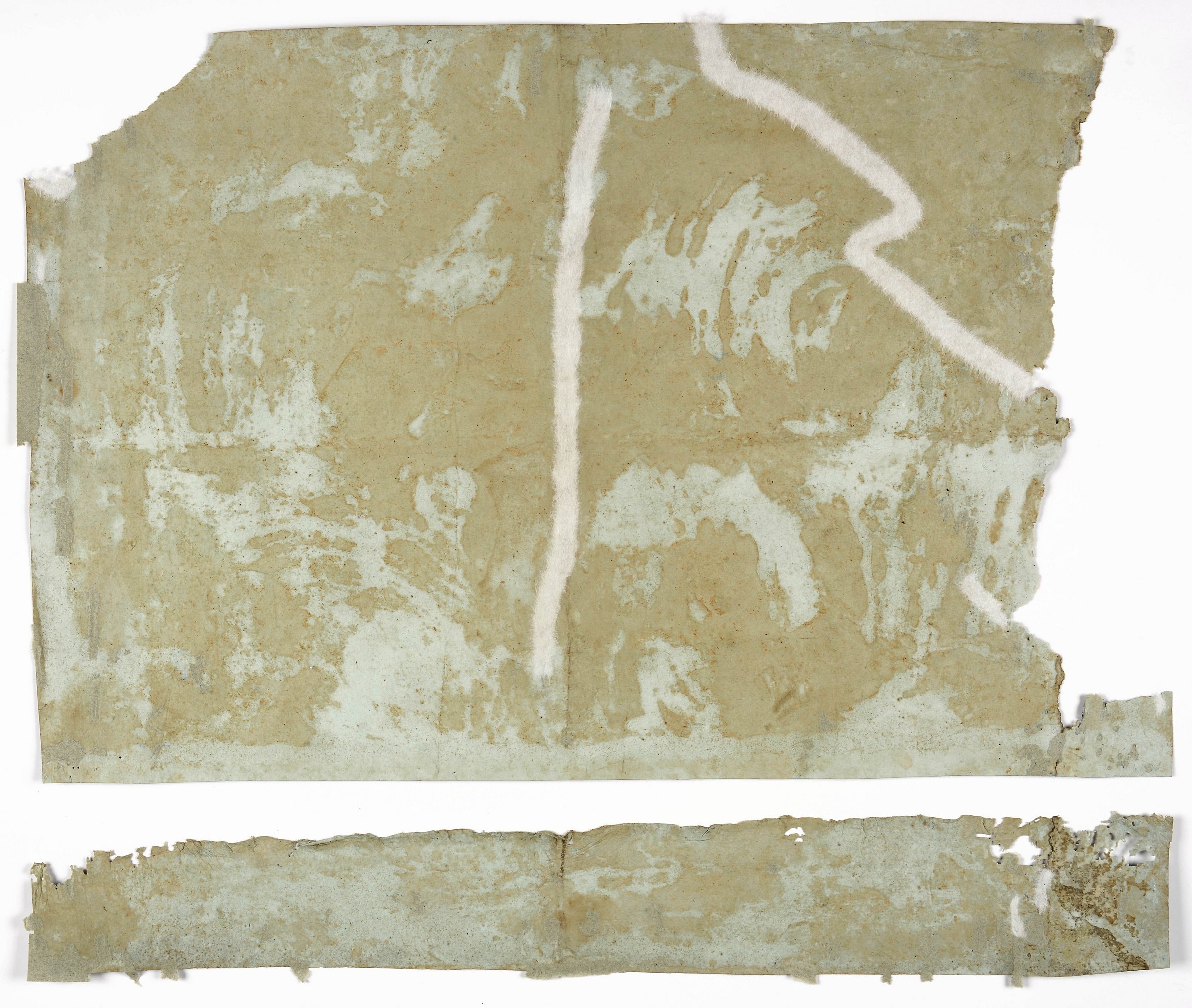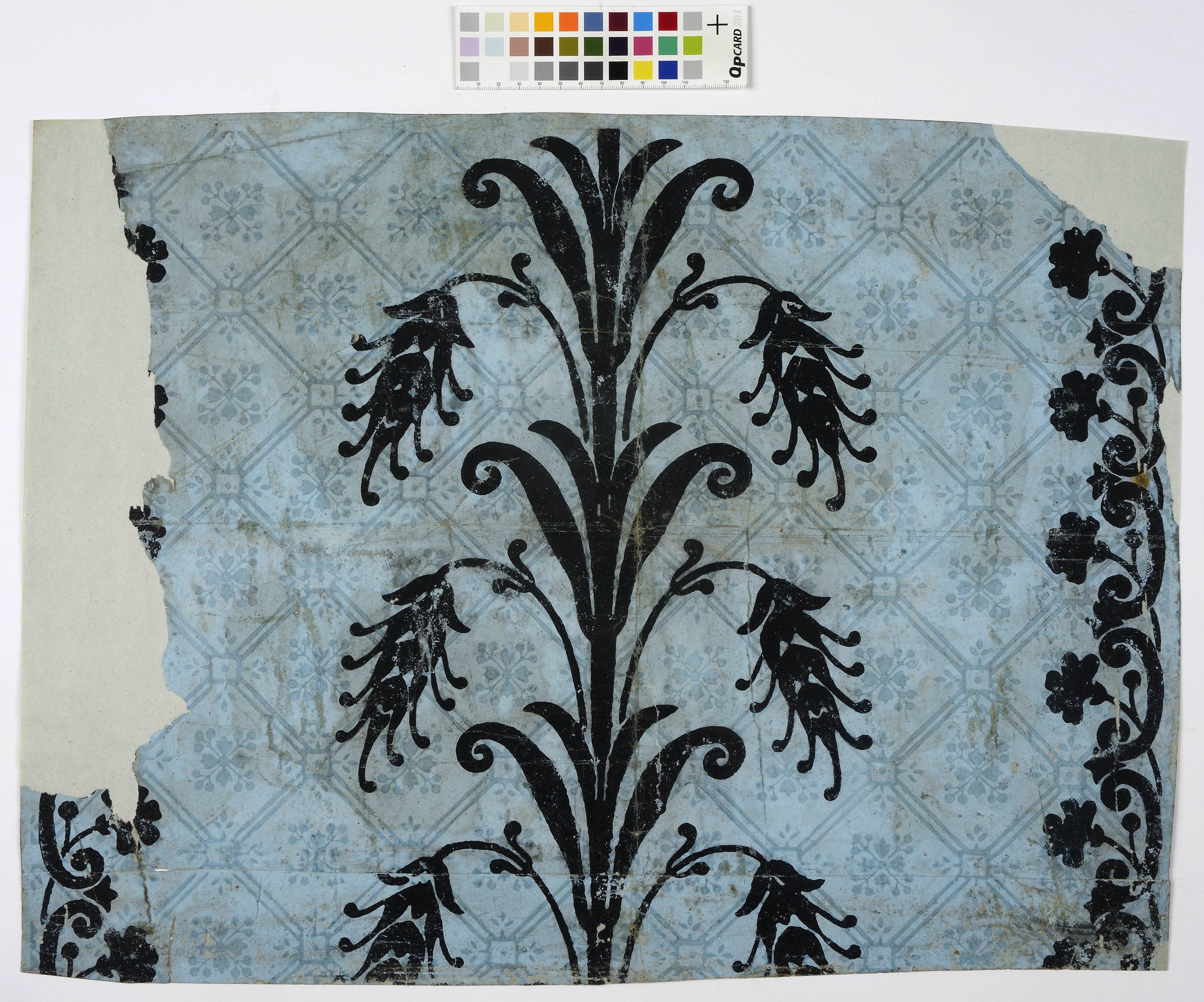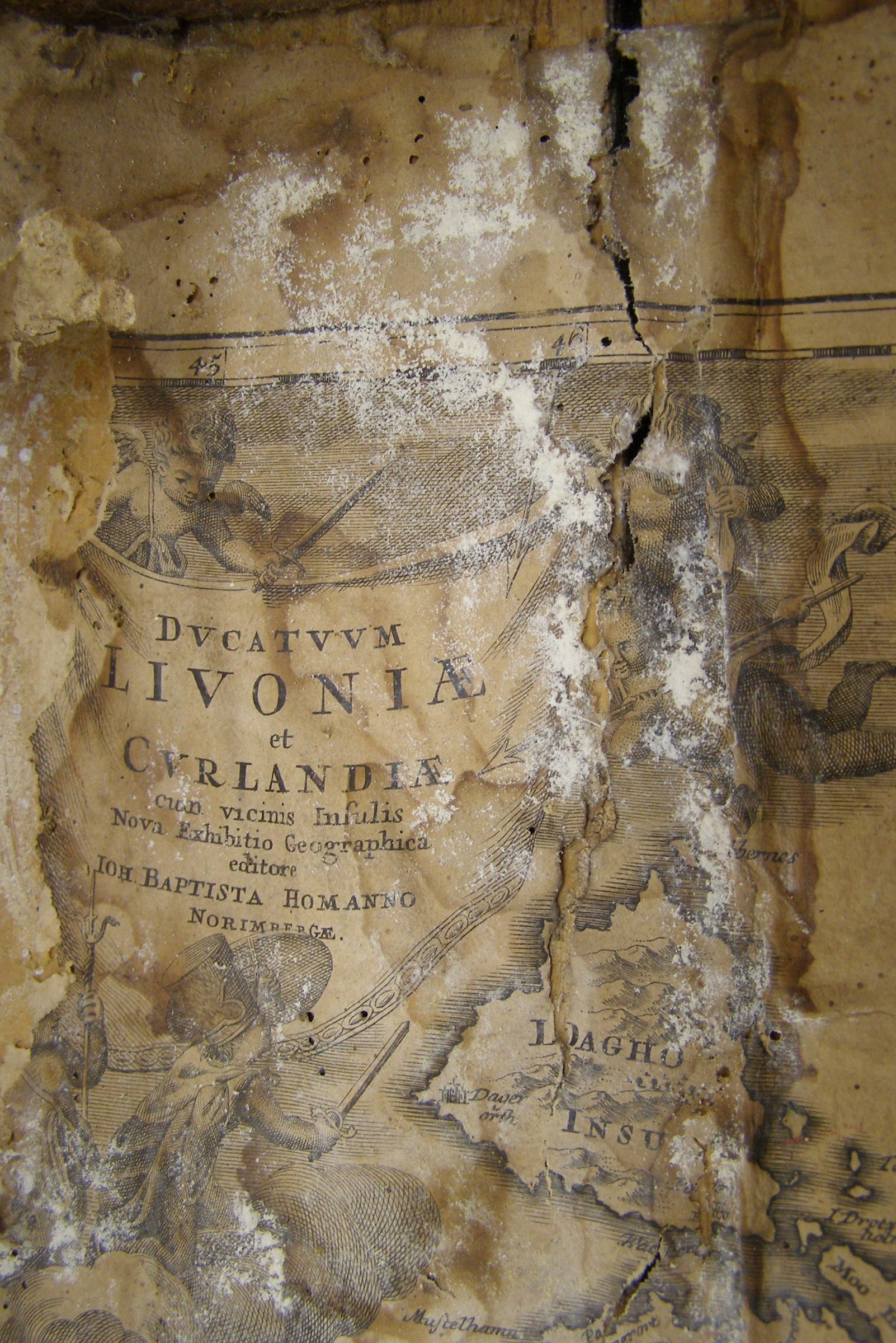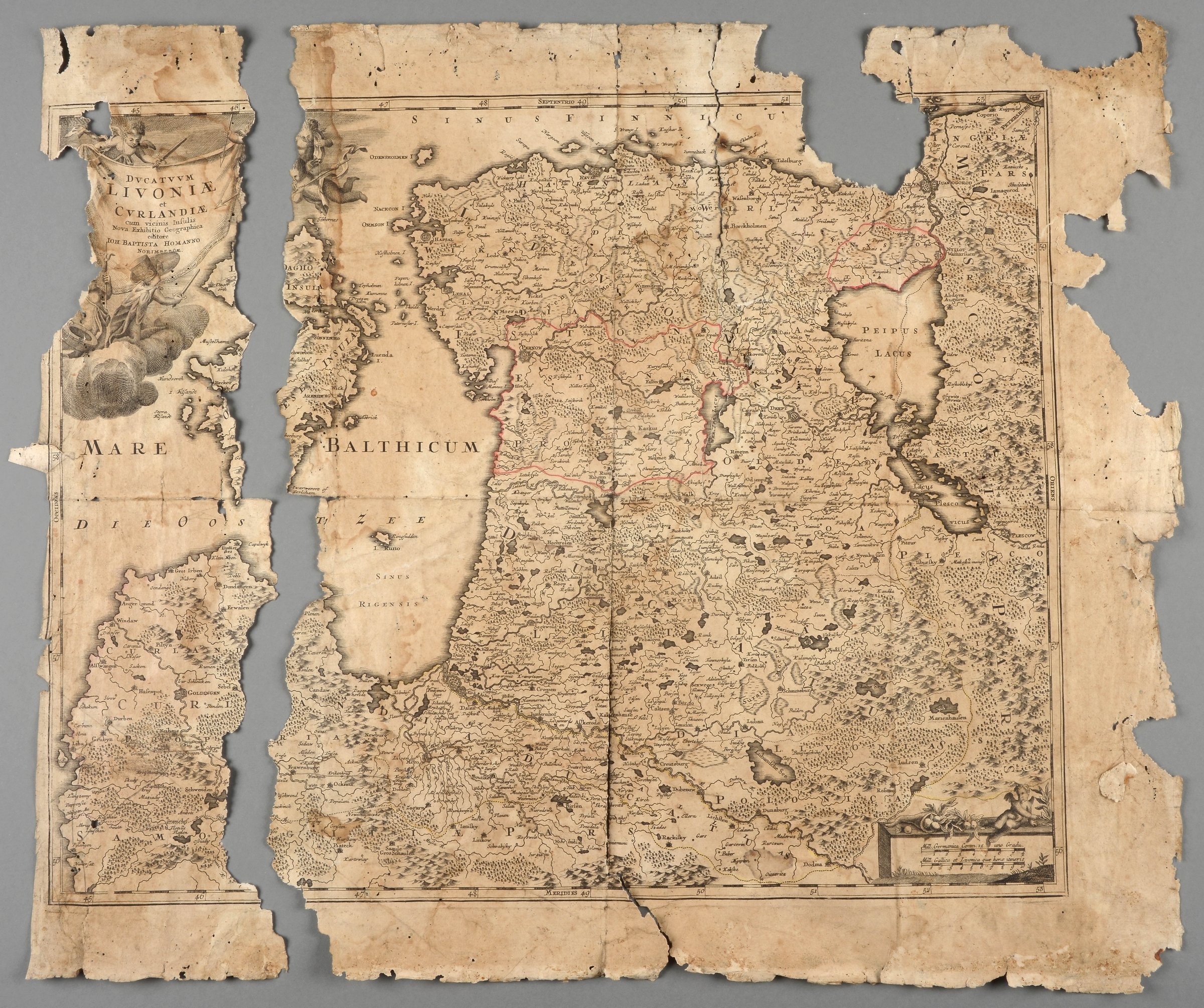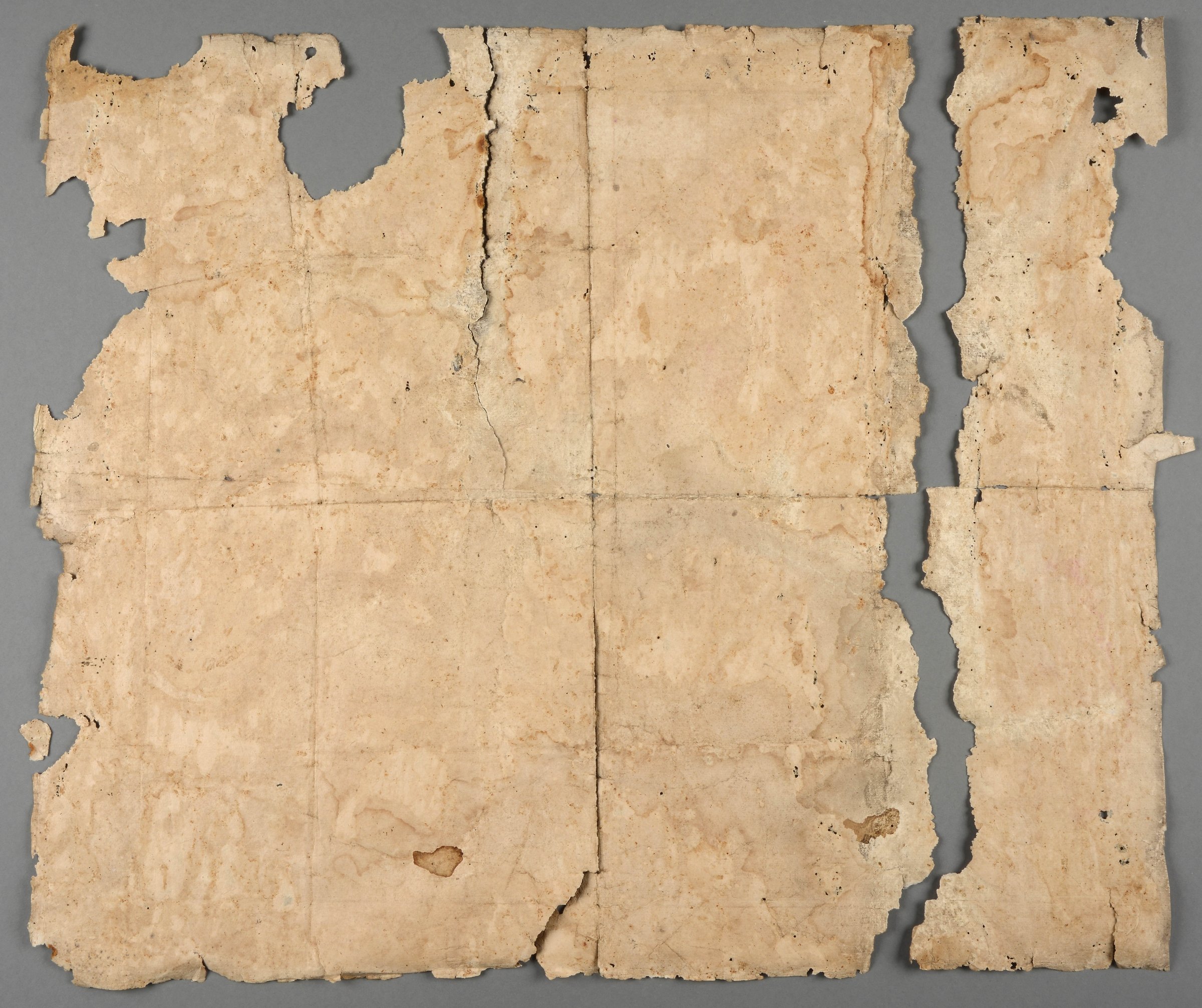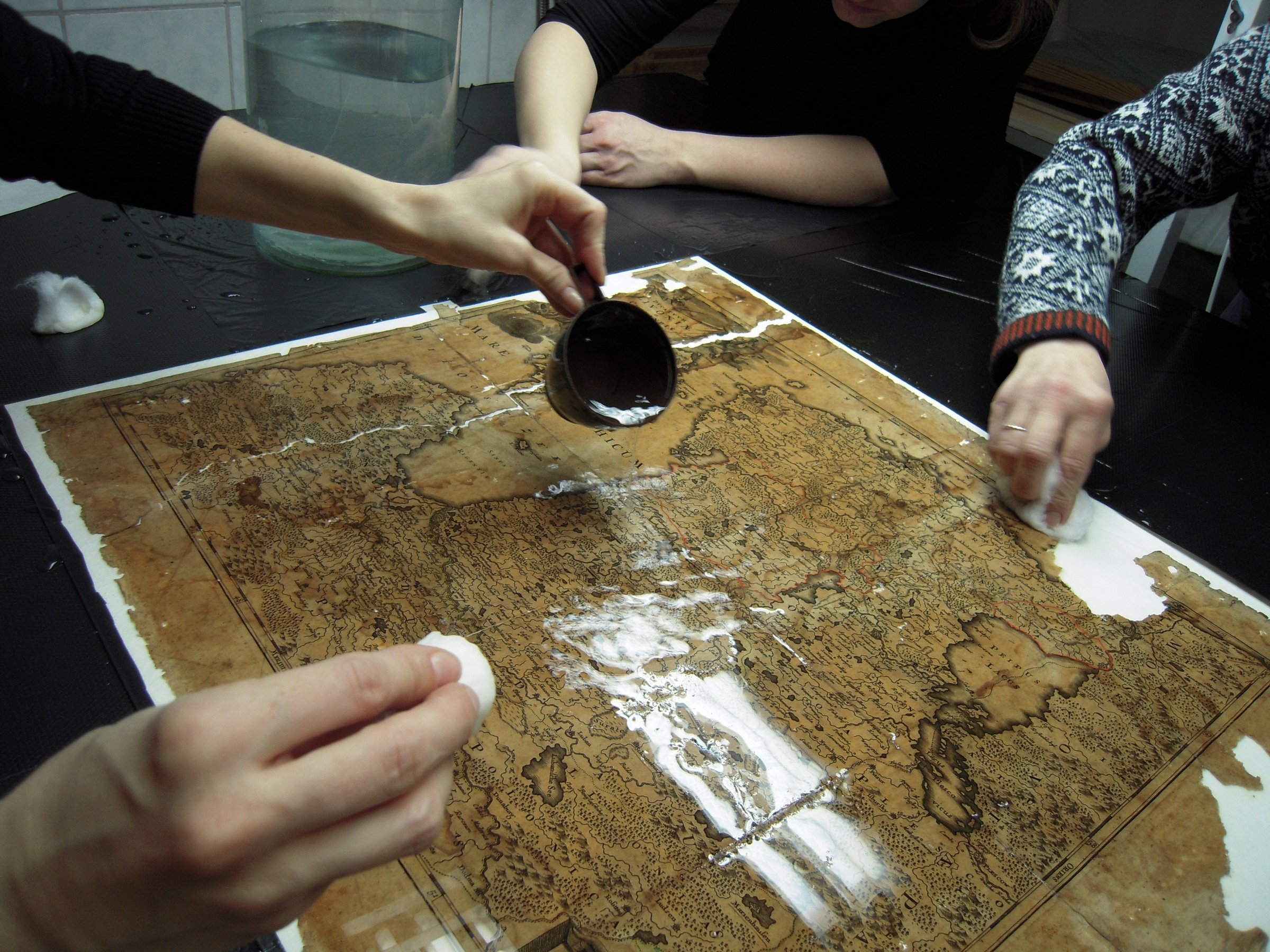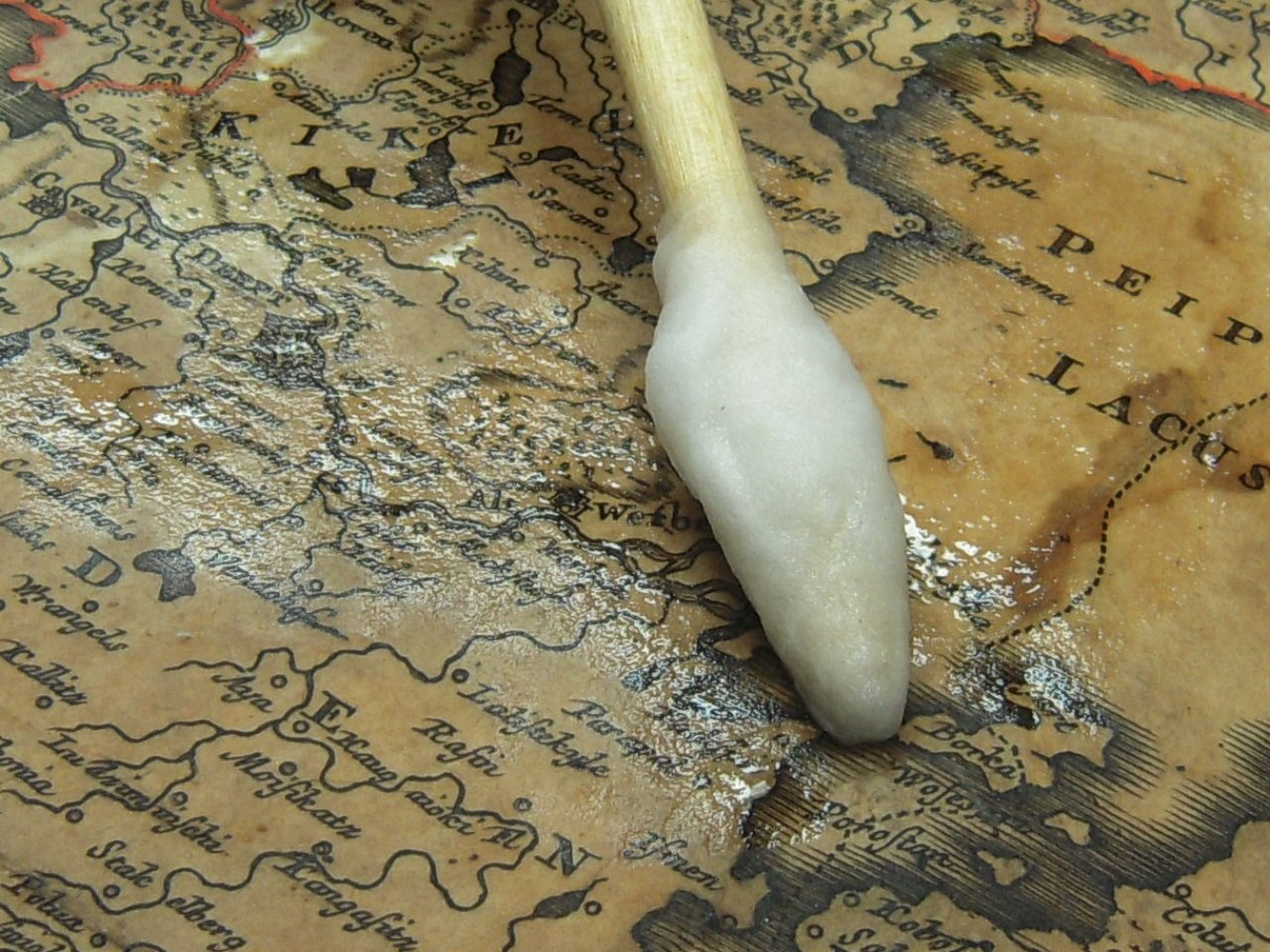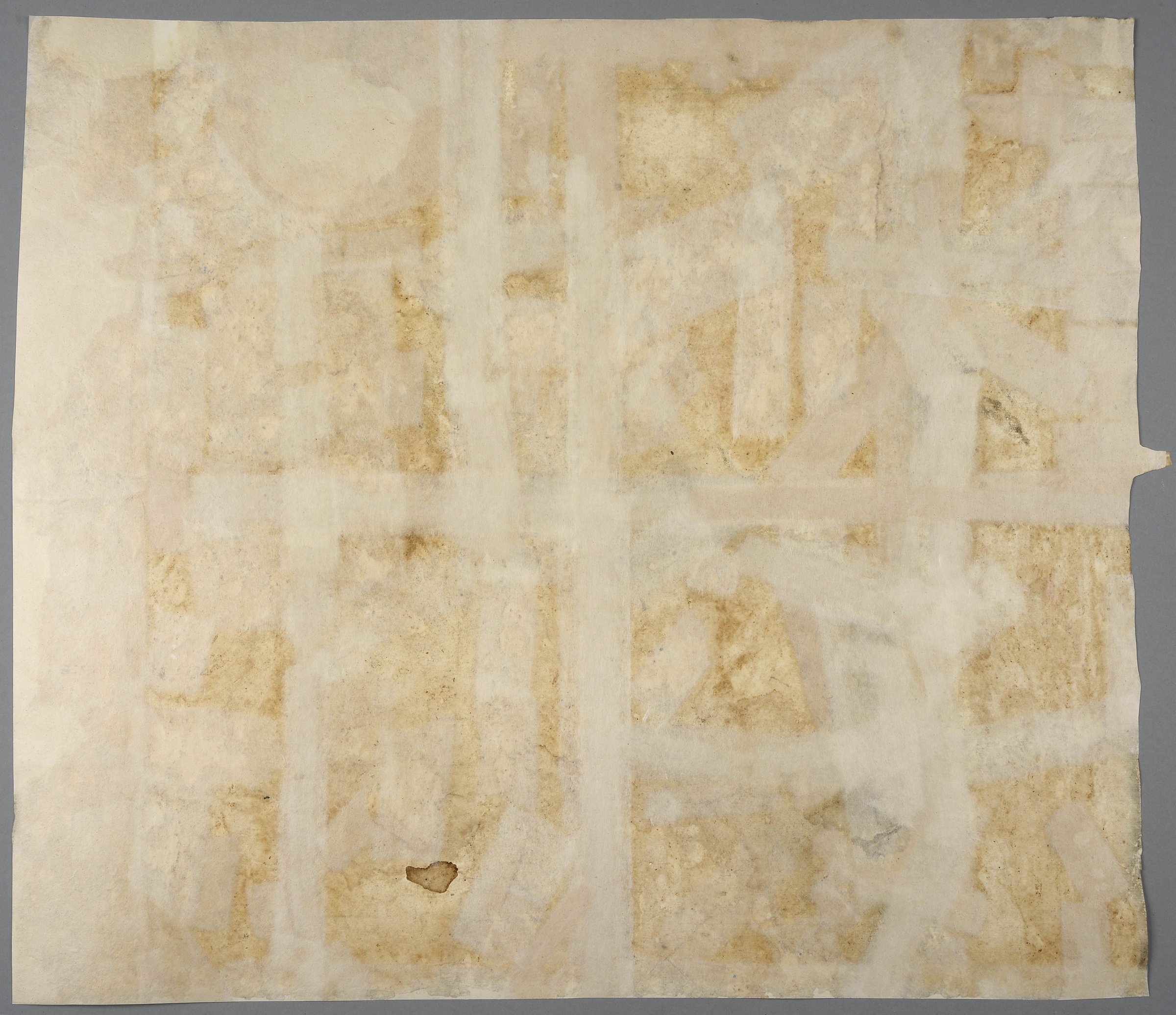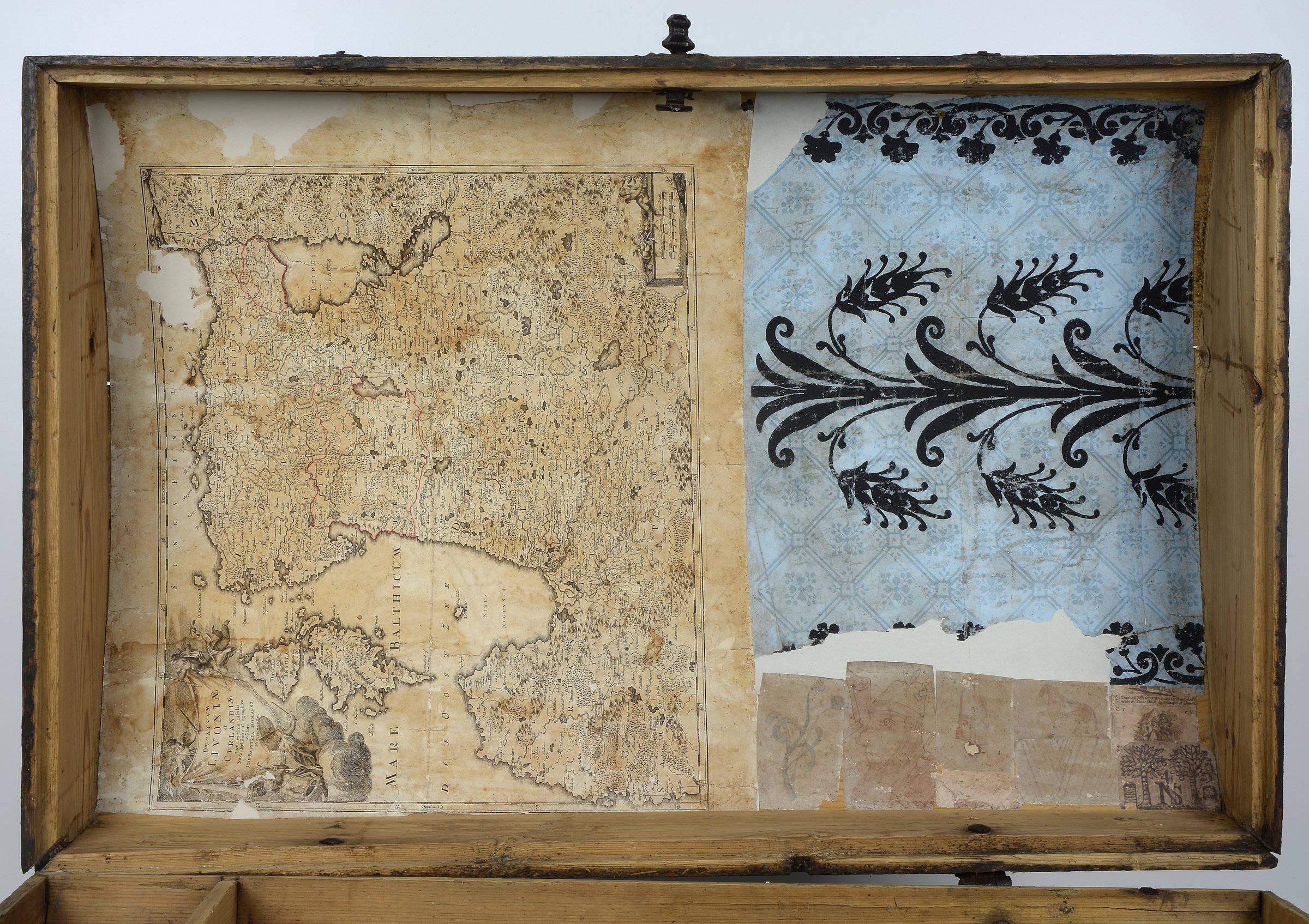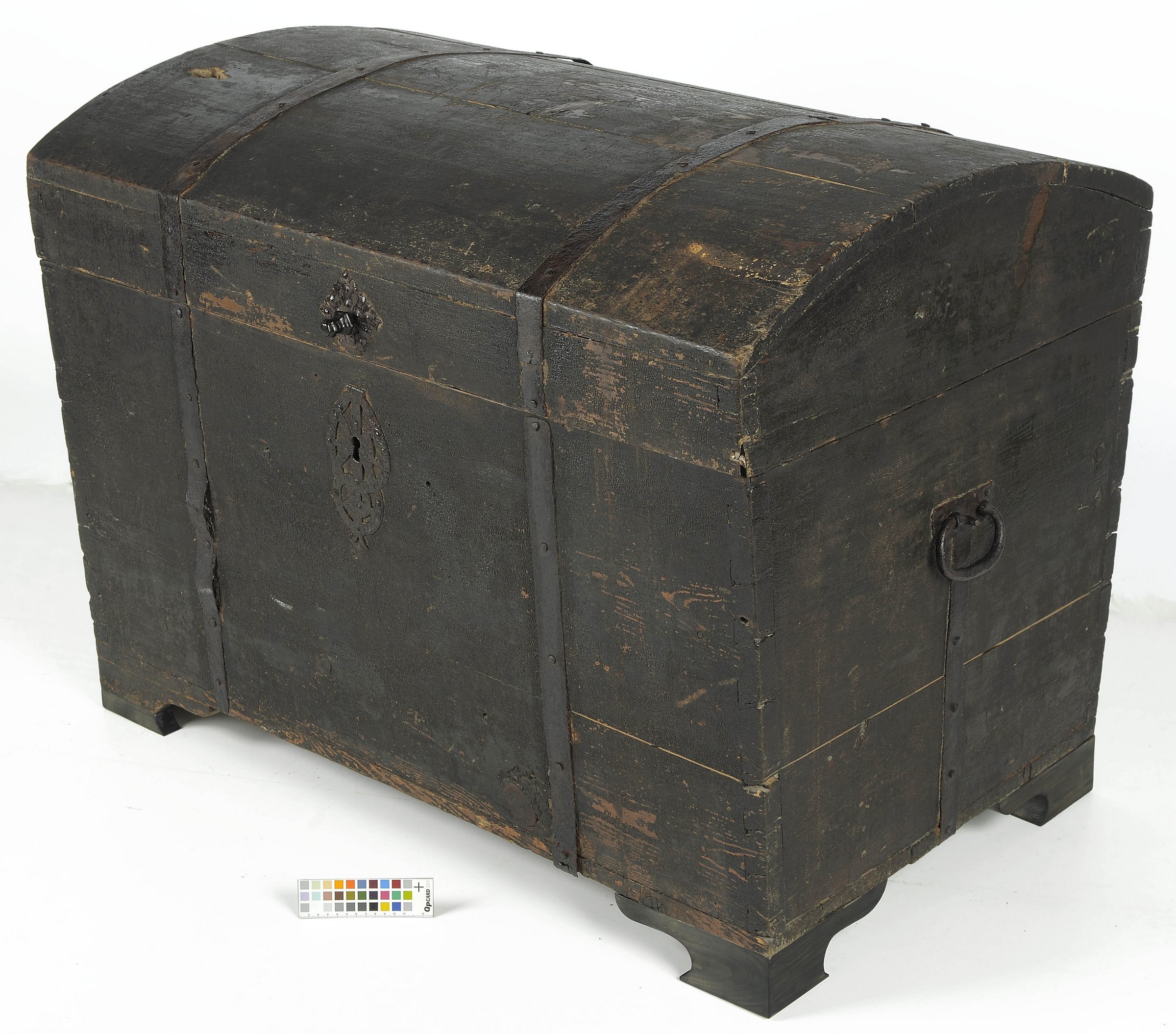AN INTERESTING FIND IN A CHEST OF THE MAHTRA PEASANTRY MUSEUM
Autor:
Jolana Laidma
Year:
Anno 2015
Category:
Conservation
n 2014 quite an ordinary seaman’s chest was waiting for its turn to be conserved at the Kanut centre. Its lock had rusted and could not be opened, so the museum people had no idea what the chest contained. Unfortunately, the Mahtra Museum had information neither about the former owners or the chest’s origin. When eventually opened, it turned out that the lid of the empty chest had been lined with various paper objects that had to be removed before conservation. Quite soon it became clear that no ordinary waste paper had been used but something much more exciting. Beneath dust and mould were fragments of wallpaper and others of a map as well as eight small pictures – six of them drawings and two prints. The conservator became especially interested in the wallpaper and map.
CONDITION OF THE PAPER OBJECTS BEFORE CONSERVATION
Despite the bad condition of paper and its variegated damages (mould, soil and sand stains, moisture and insect damages and tears) the objects could be detached and removed without further harm. They had been made of high-quality rag paper that had not lost its durability. The wallpaper and map had several losses and a nest of a mouse on the bottom of the chest yielded, indeed, pieces of both.
DESCRIPTION OF A WALLPAPER FRAGMENT
The fragment from the lid had been made of rag paper. The pieces of wallpaper allowed the conservator to restore the width of the strip and determine its pattern. The lower part of the fragment revealed the joining place of the sheets, showing that the sheets were handmade (41x 56 cm). The sheets had been glued together into strips with necessary length. The wallpaper was printed in block technique using three colours – the background is blue and the ornament light blue and black. The wallpapers of the early 19th century were light-coloured and the paper in question could have been suitable for a Biedermeier interior, as it imitates the colours and ornament of that-time silk and cotton fabrics.
Considering the above-said, we may assume that the paper was made and printed before the 1830s. It is complicated to determine its origin. It has been thought that the wallpaper might have been made in Estonia due to its national-romantic design but it cannot be proved. Kadri Kallaste who is studying the history of wallpaper confirms that very few pieces of wallpaper printed in Estonia before the first half of the 19th century have been found.
CONSERVATION
Loose dirt was removed from the surface with a vacuum cleaner and soot-sponge. The more firmly adhered dirt spots (glue and flyspecks) were removed with a scalpel. After dry-cleaning the black print was fixed with 1 %- gelatine liquor. Gelatine-treatment was repeated for three times in order to protect the black colour from the procedures in a water-tub. Before the new layer was applied the previous one was let to dry for a couple of days. The blue tones were not sensitive to water.
For washing the wallpaper, treatment in water-tub was chosen, as the small size of the object and the efficiency of the rag paper allowed it. The wallpaper was washed and lifted between Holitex fabric to be dried between felts in a press.
To restore the piece as a whole item, the edges of tears were thinned with a scalpel and a special blade to grant a better joining. The tears were mended with strips of Japanese paper and the small holes were filled with pulp. The glued parts that had become loose in water were restored. As the width and length of the wallpaper strip were known, the losses in the edges were filled with repair paper and thus the visual whole was achieved. The toned repair paper matched the original colour of the rag paper.
DESCRIPTION OF THE MAP OF OLD LIVONIA
The map of Old Livonia (58.5 x 69 cm) found in the chest is not such a rare item as the fragment of wallpaper described above but it was still a valuable and interesting find. The definition of Old Livonia marks a political and territorial unit that existed from the 13th up to the 16th century and covered roughly the present territory of Estonia and Latvia.
The map shows Livonia, Estonia, Courland and the Baltic coast together with the Gulf of Riga and Livonia. The map is rich in detail and presents quite many place names. The head of the map consists of the following text – “Ducatuum Livonia Et Curlandiae Cum Vicinis Insulis Nova Exhibitio Geographica, Editore Joh. Baptista Homanno Norimbergae”, copper cut (1717-1720).
Joh. Baptista Homann was a renowned engraver, cartographer and scientist and one of the most prolific publishers of maps in the 18th century.
The map was printed on rag paper and partly coloured. The territories are separated by dotted lines that have been coloured red and some of the areas have been tainted greenish.
Acidity of the paper (the pH value) was a little over 5.0 and the engraving had turned yellow. The paper had not only tears and holes but also moisture and mould damages in it. The latter had left stains and well-defined water streamlines that had caused losses of the initial adhesion.
CONSERVATION
The surface of the map was cleaned alike the wallpaper fragment. The water-sensitive colouring was fixed with 1 %-gelatine liquor. Vacuum washing-board that allowed more comfortable activity was used for wet treatment.
In order to diminish the map’s yellowish shading and acidity, it was washed in water, the pH value of which had been raised to 8.0 with ammonium hydroxide NH3 •H2O. General chemical treatment was applied with 2.5 %-EDTA solution and splotches were treated locally with 5 %-EDTA solution. After every procedure the chemical residue was rinsed out with running water.
The mostly leached out surface dirt was removed with gelatinous MC solution, using cotton swabs for dabbing. The Holytex-supported object was lifted to dry between felt.
The paper was adhered with a 0.5 %-gelatine solution and repairs were made on the light-table illuminated from below. The object was kept damp between plastic sheets and, if necessary, the paper was sprayed with 40 %-ethanol solution in order to guarantee equable moisture level on the whole map. The fragments of the map were joined on the light-table and backed with Japanese paper strips in various size and thickness. The edges of the tears were thinned to guarantee better contacts with repair paper. Wheat-meal paste with 0.5 %-gelatine solution was used for gluing. Only warm glue was used. The map was drying in press between filter-cartons for over a month.
PRESERVATION OF THE OBJECT IN THE MUSEUM AFTER CONSERVATION
Unfortunately, the Mahtra Museum does not possess rooms with stabile climatic conditions. (Their storerooms are located in a former granary.) That is why it was decided to keep the paper objects separately, and not in the chest and a special cardboard wrap was prepared to preserve them in. Such wraps are common in museum storerooms for original documents. To retain a better visual whole of the chest print copies were made of the originals and these decorate the inner side of the lid now. To get a high-quality copy the originals were digitised at the Kanut centre’s photo studio and the files were printed at the Digifoto studio.
The object was conserved by Jolana Laidma (paper materials and cardboard wraps), Mart Verevmägi (woodwork) and Helmut Välja (metalwork).
REFERENCES:
Riidekirst, SA Juuru ja Hageri Kihelkonna Muuseumid / Mahtra Talurahvamuuseum. SA Eesti Vabaõhumuuseum Konserveerimis- ja digiteerimiskeskus Kanut Konserveerimistööde aruanne 2009-W-017.
http://et.wikipedia.org/wiki/Paber#Paberivalmistamine_Euroopas (18.05.2015)
Kirjavahetus Kadri Kallastega teemal „Ajalooline tapeet“
http://www.iscra.nl/E2314,Antique-map,Baltic-Coast,Luvonia-et-Curlandiae,J.-B.-Homann.htm (18.05.2015)
http://www.geographicus.com/P/AntiqueMap/homann#sthash.othwRYxn.dpuf (18.05.2015)

